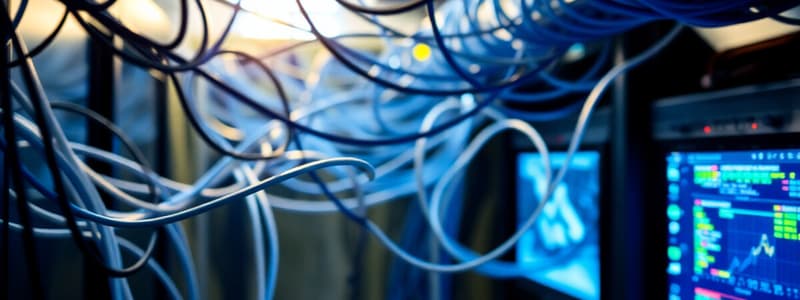Podcast
Questions and Answers
What is the correct order of data encapsulation from the application layer to the data link layer?
What is the correct order of data encapsulation from the application layer to the data link layer?
- Application data → Segments → Frames → Packets
- Application data → Segments → Packets → Frames (correct)
- Application data → Frames → Segments → Packets
- Application data → Packets → Segments → Frames
Which of the following is NOT a layer of the OSI model?
Which of the following is NOT a layer of the OSI model?
- Transport
- Application
- Hardware (correct)
- Network
What is the primary purpose of IP addresses in networking?
What is the primary purpose of IP addresses in networking?
- To ensure data integrity during transport
- To manage local area connections
- To organize data packets for faster transmission
- To identify source and destination for end-to-end delivery (correct)
Which network type covers a large geographic area but typically has slower connection speeds?
Which network type covers a large geographic area but typically has slower connection speeds?
Which of the following best describes the role of the Transport Layer in the TCP/IP model?
Which of the following best describes the role of the Transport Layer in the TCP/IP model?
What is a primary goal of network security?
What is a primary goal of network security?
Which emerging trend allows users to access network resources from various devices?
Which emerging trend allows users to access network resources from various devices?
What is a characteristic of a Local Area Network (LAN)?
What is a characteristic of a Local Area Network (LAN)?
Which of the following is an example of an intermediary device?
Which of the following is an example of an intermediary device?
Which feature of a network ensures minimal failures?
Which feature of a network ensures minimal failures?
What does BYOD stand for in networking trends?
What does BYOD stand for in networking trends?
Which threat is classified as an external security threat?
Which threat is classified as an external security threat?
What is packet switching designed to improve in a network?
What is packet switching designed to improve in a network?
Which of the following options best describes network topology?
Which of the following options best describes network topology?
What is a primary function of protocols in communication?
What is a primary function of protocols in communication?
LAN covers a large geographic area such as cities and countries.
LAN covers a large geographic area such as cities and countries.
The Internet is a global collection of plugged-in LANs and WANs.
The Internet is a global collection of plugged-in LANs and WANs.
Intermediary devices help to manage data flow in a network.
Intermediary devices help to manage data flow in a network.
Quality of Service (QoS) ensures all data types are treated equally in a network.
Quality of Service (QoS) ensures all data types are treated equally in a network.
BYOD allows employees to use only company-owned devices for work.
BYOD allows employees to use only company-owned devices for work.
Copper cables, fiber optics, and wireless are types of network media.
Copper cables, fiber optics, and wireless are types of network media.
Fault tolerance in networking refers to the ability to grow without performance loss.
Fault tolerance in networking refers to the ability to grow without performance loss.
Packet switching is designed to enhance data delivery by consolidating traffic into large packets.
Packet switching is designed to enhance data delivery by consolidating traffic into large packets.
Encapsulation refers to wrapping data in protocol layers like envelopes.
Encapsulation refers to wrapping data in protocol layers like envelopes.
The OSI model has eight layers.
The OSI model has eight layers.
TCP is responsible for assigning IP addresses to devices.
TCP is responsible for assigning IP addresses to devices.
A MAC address is used for end-to-end delivery of data across networks.
A MAC address is used for end-to-end delivery of data across networks.
WANs typically have higher speeds than LANs.
WANs typically have higher speeds than LANs.
BYOD stands for Bring Your Own Device and refers to the practice of users accessing a network with personal devices.
BYOD stands for Bring Your Own Device and refers to the practice of users accessing a network with personal devices.
Network security primarily aims to ensure data availability for all users, authorized or not.
Network security primarily aims to ensure data availability for all users, authorized or not.
Flashcards
Network Types
Network Types
Different networks, like LAN (local area networks), WAN (wide area networks), and the internet, connect devices over varying distances and with different levels of control.
Network Components
Network Components
Networks consist of end devices (computers, phones), intermediary devices (routers, switches), and data transmission media (cables, wireless).
Network Architectures
Network Architectures
Reliable networks feature fault tolerance (redundancy to prevent failure), scalability (growth without performance loss), QoS (prioritization of essential data), and security (protection from breaches).
Network Security Threats
Network Security Threats
Signup and view all the flashcards
Network Security Solutions
Network Security Solutions
Signup and view all the flashcards
Network Communication Rules
Network Communication Rules
Signup and view all the flashcards
Packet Switching
Packet Switching
Signup and view all the flashcards
Network Interface Card (NIC)
Network Interface Card (NIC)
Signup and view all the flashcards
Data Encapsulation
Data Encapsulation
Signup and view all the flashcards
Network Protocol
Network Protocol
Signup and view all the flashcards
TCP/IP Model
TCP/IP Model
Signup and view all the flashcards
IP Address
IP Address
Signup and view all the flashcards
LAN (Local Area Network)
LAN (Local Area Network)
Signup and view all the flashcards
WAN (Wide Area Network)
WAN (Wide Area Network)
Signup and view all the flashcards
Network Security
Network Security
Signup and view all the flashcards
What do networks allow?
What do networks allow?
Signup and view all the flashcards
LAN vs. WAN
LAN vs. WAN
Signup and view all the flashcards
Internet Connection
Internet Connection
Signup and view all the flashcards
Fault Tolerance
Fault Tolerance
Signup and view all the flashcards
What is BYOD?
What is BYOD?
Signup and view all the flashcards
Cloud Computing
Cloud Computing
Signup and view all the flashcards
Types of Network Security Threats
Types of Network Security Threats
Signup and view all the flashcards
Data Encapsulation: What's the process?
Data Encapsulation: What's the process?
Signup and view all the flashcards
Network Protocols: What are they for?
Network Protocols: What are they for?
Signup and view all the flashcards
What's the difference between IP and MAC addresses?
What's the difference between IP and MAC addresses?
Signup and view all the flashcards
OSI Model Layers: How many and what for?
OSI Model Layers: How many and what for?
Signup and view all the flashcards
Security Goals: Confidentiality, Integrity, Availability
Security Goals: Confidentiality, Integrity, Availability
Signup and view all the flashcards
LAN vs. WAN: Where do they differ?
LAN vs. WAN: Where do they differ?
Signup and view all the flashcards
BYOD, Cloud, Collaboration: What are the trends?
BYOD, Cloud, Collaboration: What are the trends?
Signup and view all the flashcards
Study Notes
Introduction to Networks
- Networks connect devices globally for communication, learning, work, and entertainment.
- Communication methods include texting, social media, collaboration, blogs, and gaming.
Network Types
- LAN (Local Area Network): Covers a small area (home, office, campus), high-speed bandwidth, single administration.
- WAN (Wide Area Network): Connects LANs over large areas (cities, countries), managed by multiple providers, slower speeds.
- Internet: A global network of LANs and WANs, connected via copper, fiber optic, and wireless media.
Network Components
- End Devices: Devices originating or receiving messages (e.g., computers, phones).
- Intermediary Devices: Manage data flow (e.g., routers, switches, firewalls).
- Media Types: Copper cables, fiber optics, wireless.
Network Architectures
- Fault Tolerance: Redundancy to minimize failures.
- Scalability: Ability to grow without performance loss.
- Quality of Service (QoS): Prioritization of data (e.g., video, voice).
- Security: Protecting infrastructure and data (confidentiality, integrity, availability).
Networking Trends
- BYOD (Bring Your Own Device): Employees using personal devices for company access.
- Cloud Computing: Storing/accessing data over the internet (public, private, hybrid clouds).
- Online Collaboration & Video Communication: Tools like Cisco WebEx and TelePresence.
- Smart Homes: Integrating technology into appliances.
Network Security
- Threats (External): Viruses, hacking, denial-of-service attacks.
- Threats (Internal): Accidental/intentional breaches by employees.
- Solutions (Home networks): Antivirus, firewalls.
- Solutions (Large networks): Access control lists (ACLs), intrusion prevention systems (IPS), VPNs.
Key Network Concepts (Chapter 2/1)
- Communication Fundamentals: Sender, receiver, and medium (channel) are essential. Protocols manage message formats, timing, and delivery.
- Data Encapsulation: Data wrapped in protocol layers (e.g., frame, packet).
- Network Protocols & Standards: Protocols (e.g., HTTP, TCP, IP) ensure interoperability.
- Addressing: IP addresses for end-to-end delivery; MAC addresses for local network delivery.
- Network Access (Local/Remote): Local access direct; remote access uses a default gateway (router).
- Reference Models (OSI/TCP/IP): OSI model (Application, Presentation, Session, Transport, Network, Data Link, Physical); TCP/IP model (Application, Transport, Internet, Network Access).
- Network Security Principles: Confidentiality, integrity, availability. External threats include viruses, attacks, and data theft; internal threats include human errors and malicious activity.
- Network Types: LANs (small, high speed), WANs (large, slower speed).
- Emerging Trends: BYOD, cloud computing, online collaboration, video communication.
- Internet Structure: LANs and WANs connect through ISPs. Intranets/extranets are private networks.
Study Focus
- Understand protocol layers (OSI vs. TCP/IP).
- Knowledge of the data encapsulation process.
- Understanding security practices (identifying and mitigating threats).
- Differentiating between LANs and WANs, and identifying different network types.
- Awareness of emerging trends (BYOD, cloud, collaboration).
Studying That Suits You
Use AI to generate personalized quizzes and flashcards to suit your learning preferences.




